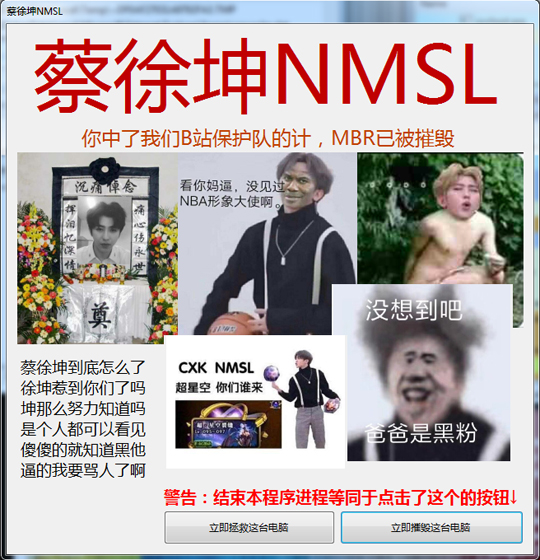Ransom.Win32.CAI.THJBBAIA
Trojan.Win32.Diztakun.bnzw (Kaspersky)
Windows


Threat Type: Ransomware
Destructiveness: No
Encrypted:
In the wild: Yes
OVERVIEW
Downloaded from the Internet
This Ransomware arrives on a system as a file dropped by other malware or as a file downloaded unknowingly by users when visiting malicious sites.
It disables Task Manager, Registry Editor, and Folder Options.
TECHNICAL DETAILS
40,826,461 bytes
EXE
Yes
25 Oct 2019
Displays graphics/image, Encrypts files
Arrival Details
This Ransomware arrives on a system as a file dropped by other malware or as a file downloaded unknowingly by users when visiting malicious sites.
Installation
This Ransomware adds the following processes:
- %User Temp%\bss\fucktsk.bat
- %User Temp%\bss\restsk.bat
- %User Temp%\bss\ikun-helper.exe
- %User Temp%\bss\cxknmsl-malware.exe
(Note: %User Temp% is the current user's Temp folder, which is usually C:\Documents and Settings\{user name}\Local Settings\Temp on Windows 2000(32-bit), XP, and Server 2003(32-bit), or C:\Users\{user name}\AppData\Local\Temp on Windows Vista, 7, 8, 8.1, 2008(64-bit), 2012(64-bit) and 10(64-bit).)
It creates the following folders:
- %User Temp%\bss
(Note: %User Temp% is the current user's Temp folder, which is usually C:\Documents and Settings\{user name}\Local Settings\Temp on Windows 2000(32-bit), XP, and Server 2003(32-bit), or C:\Users\{user name}\AppData\Local\Temp on Windows Vista, 7, 8, 8.1, 2008(64-bit), 2012(64-bit) and 10(64-bit).)
Other System Modifications
This Ransomware adds the following registry keys:
HKEY_CURRENT_USER\Software\Microsoft\
Windows\CurrentVersion\Policies\
System
It creates the following registry entry(ies) to disable Task Manager, Registry Tools and Folder Options:
HKEY_CURRENT_USER\Software\Microsoft\
Windows\CurrentVersion\Policies\
System
DisableTaskMgr = "1"
Dropping Routine
This Ransomware drops the following files:
- %User Temp%\bss\fucktsk.reg - contains registry to import
- %User Temp%\bss\restsk.reg - contains registry to import
- %User Temp%\bss\cxknmsl-malware.exe - file that displays the note
- %User Temp%\bss\ikun-helper.exe - file to overwrite MBR
- %User Temp%\bss\biliapi.exe - causes bluescreen to force the pc to restart
- %User Temp%\bss\fucktsk.bat - import corresponding reg file
- %User Temp%\bss\restsk.bat - import corresponding reg file
(Note: %User Temp% is the current user's Temp folder, which is usually C:\Documents and Settings\{user name}\Local Settings\Temp on Windows 2000(32-bit), XP, and Server 2003(32-bit), or C:\Users\{user name}\AppData\Local\Temp on Windows Vista, 7, 8, 8.1, 2008(64-bit), 2012(64-bit) and 10(64-bit).)
Other Details
This Ransomware displays the following images:
It overwrites the Master Boot Record (MBR) with the following strings:
SOLUTION
9.850
15.448.05
23 Oct 2019
15.449.00
24 Oct 2019
Step 1
Before doing any scans, Windows 7, Windows 8, Windows 8.1, and Windows 10 users must disable System Restore to allow full scanning of their computers.
Step 2
Identify and terminate files detected as Ransom.Win32.CAI.THJBBAIA
- Windows Task Manager may not display all running processes. In this case, please use a third-party process viewer, preferably Process Explorer, to terminate the malware/grayware/spyware file. You may download the said tool here.
- If the detected file is displayed in either Windows Task Manager or Process Explorer but you cannot delete it, restart your computer in safe mode. To do this, refer to this link for the complete steps.
- If the detected file is not displayed in either Windows Task Manager or Process Explorer, continue doing the next steps.
Step 3
Enable Registry Editor, Task Manager, and Folder options
Step 4
Delete this registry key
Important: Editing the Windows Registry incorrectly can lead to irreversible system malfunction. Please do this step only if you know how or you can ask assistance from your system administrator. Else, check this Microsoft article first before modifying your computer's registry.
- In HKEY_CURRENT_USER\Software\Microsoft\Windows\CurrentVersion\Policies
- System
Step 5
Search and delete these components
- %User Temp%\bss\fucktsk.reg
- %User Temp%\bss\restsk.reg
- %User Temp%\bss\cxknmsl-malware.exe
- %User Temp%\bss\ikun-helper.exe
- %User Temp%\bss\biliapi.exe
Step 6
Search and delete this folder
- %User Temp%\bss
Step 7
Scan your computer with your Trend Micro product to delete files detected as Ransom.Win32.CAI.THJBBAIA. If the detected files have already been cleaned, deleted, or quarantined by your Trend Micro product, no further step is required. You may opt to simply delete the quarantined files. Please check the following Trend Micro Support pages for more information:
Step 8
Restore encrypted files from backup.
Did this description help? Tell us how we did.



